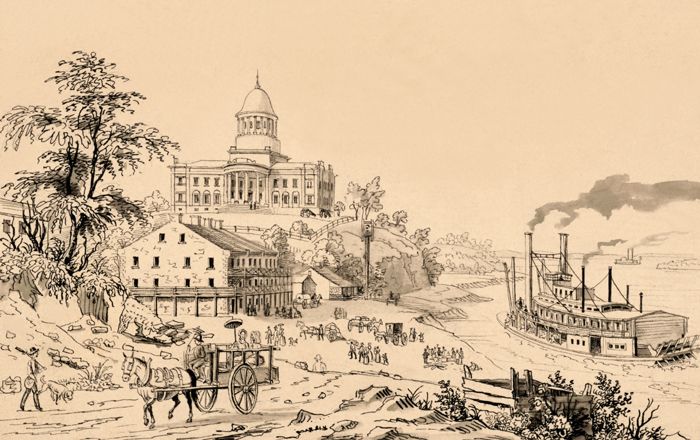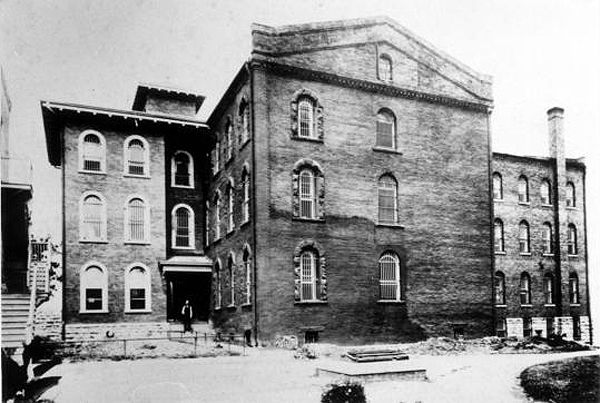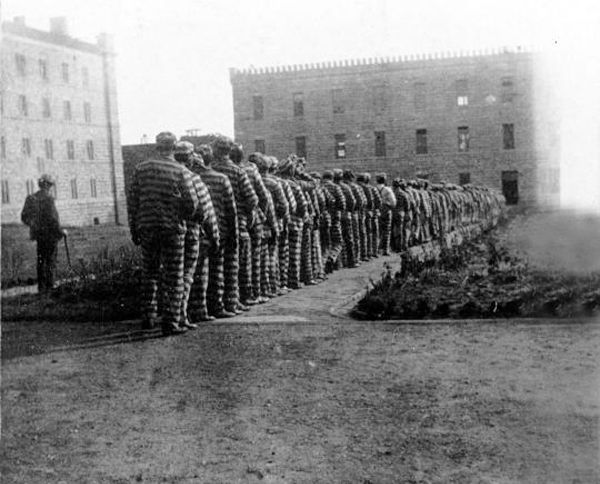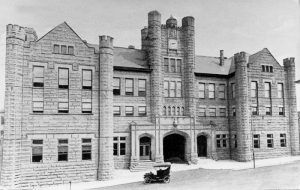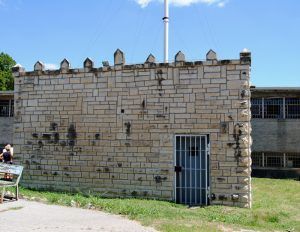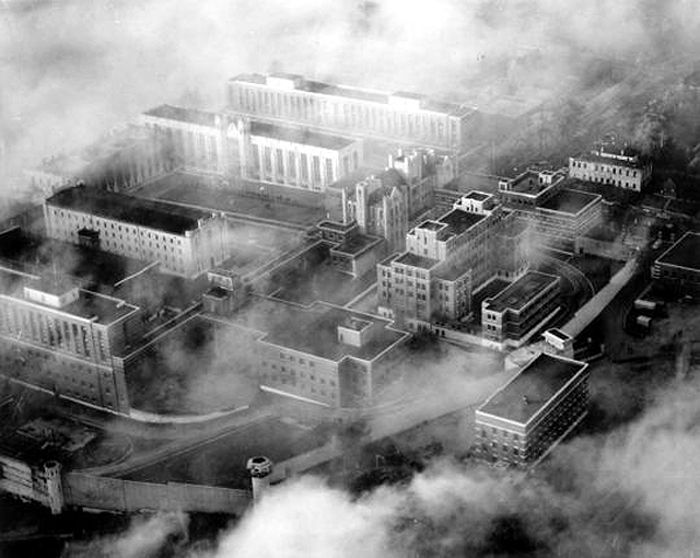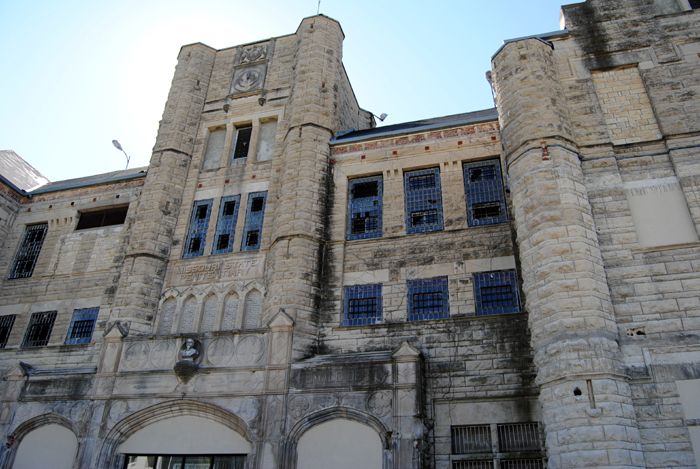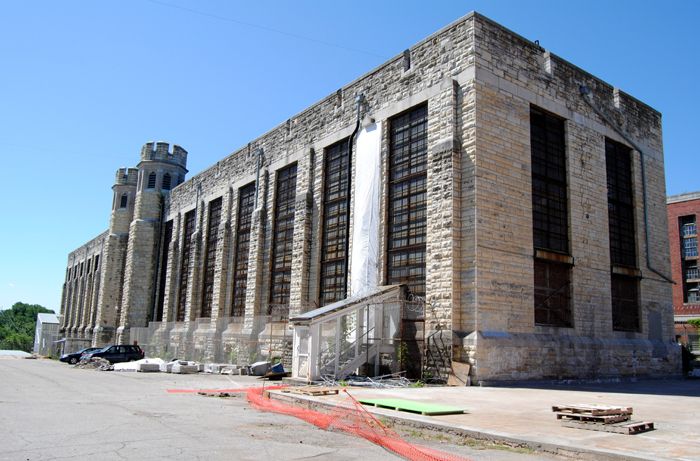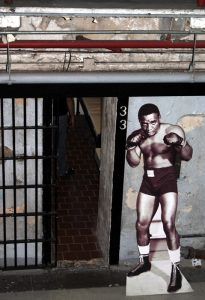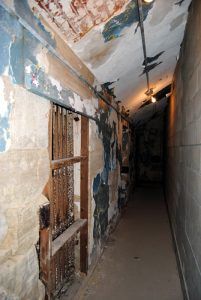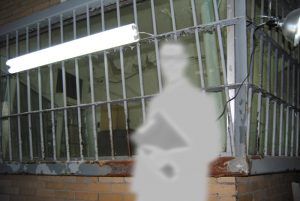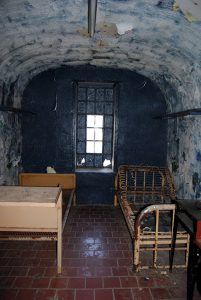Once called the “Bloodiest 47 acres in America”, the Missouri State Penitentiary in Jefferson City was the oldest continuously operating correctional institution west of the Mississippi River when it closed. As such, it should come as no surprise that it is said to be haunted.
Jefferson City became the capital of Missouri in 1822, but in the next decade, there were other towns that were vying for the opportunity to take that status for themselves. Jefferson City needed to do something to ensure that it would remain the capital city and Governor John Miller came up with the solution in 1831 when he proposed the construction of a maximum-security state penitentiary. The prison was authorized by the Missouri Legislature the next year. Construction began in 1834 and opened in 1836, the same month that the Alamo fell in Texas. Initially, it housed just 15 prisoners who worked in a shop making bricks.
When the prison, nicknamed “The Walls”, was fully completed it was surrounded by a high limestone wall with 15 officer towers.
Before long, 2,000 men were incarcerated at the penitentiary, which would be the average number of inmates for many years. The prison admitted its first female inmate in 1842.
Early on, the penitentiary operated a lease program where businessmen could hire inmates to work for them. Several buildings in Jefferson City, including the first capital, the governor’s mansion, and several area homes were built using prison labor.
In 1868, Housing Unit 4 or A Hall, was built to house post-Civil War criminals. Constructed of stone quarried on site and built mainly by inmates, it was designed by Warden Horace Swift and was in continuous use until the day the prison was closed. The massive stone building is the oldest building at the prison today and its basement, nicknamed the “Hole”, was a medieval-style dungeon that housed some of the worst criminals, including those on Death Row.
Over the years, the prison became an industrial site and by 1885, it housed six shoe factories; clothing, broom, and twine factories; and the largest saddle tree factory in the world. All were worked by prison labor.
By the turn of the century, the penitentiary was considered one of the most efficient prisons in the country and the Jefferson City Star Tribune declared it as the “Greatest in the World.”
Housing Unit 1 was constructed in 1905 to house female inmates. It now serves as the main entrance to the penitentiary. In 1914, the prison was expanded again with the addition of Housing Unit 3, which became the capital punishment and segregation unit.
According to the Department of Justice, the prison housed 4,900 inmates in 1936. However, at its highest point, the facility housed 5,200 inmates, far more than it was designed to hold, and at this time, more inmates than any other facility in the country.
In 1937, the prison gas chamber building was built by prison inmates using stone from the prison quarry. Before this, executions were conducted by hanging. The new gas chamber would become the location of 40 executions, which included the deaths of many infamous criminals such as Claude McGee, George Bell, and Bonnie B. Heady. Thirty-nine were executed in the gas chamber and the final execution was made using lethal injection in 1989. Afterward, the prison’s death row inmates were transferred to the Potosi Correctional Center in Mineral Point, Missouri.
In 1938, a five-story hospital unit with 240 beds was added to the complex.
Although many riots, murders, and escape attempts occurred over the years, one of the biggest events in the prison’s history occurred when a violent riot broke out in September 1954. In the previous two years, several other prison riots had occurred across the country and when gossip in the prison turned to talk of riots, authorities took it seriously, drafting a plan should such an event occur and training officers.
On the evening of September 22nd, two inmates feigned illness and when two guards came to investigate, they were overpowered and one was beaten severely. The prisoners then stole their keys and released other prisoners. Before long, several hundred inmates were running loose throughout the penitentiary, smashing windows and furnishings, and setting fires in the prison shops.
By midnight, the Missouri Highway Patrol, police from Kansas City and St. Louis, and national guardsmen had surrounded the prison. By that time, four buildings were on fire. Before it was over, nearly 2,500 rioters were on the loose inside the walls and the carnage continued through the night.
The authorities announced to the press that there would be no attempt to secure the cellblocks that night, but rather, the lawmen were tasked to prevent a mass breakout.
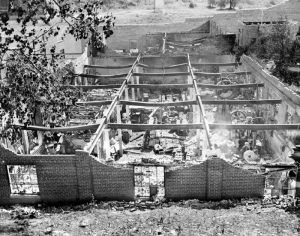
The License Plate Plant was destroyed in the 1954 riot at Missouri State Penitentiary, by the St. Louis Post-Dispatch
Early the next morning, 18 men were chosen to lead the way into the cellblocks where about 300 of the rioters were holed up in a forbidding four-story white stone building. Other armed troopers were on the roof and over 100 police officers were standing just outside the prison yard as a second wall of defense.
The officers on the roof were finally forced to open fire with machine and riot guns to remove convicts from the prison yard.
In the meantime, the 18 men tasked with going into the prison building were heavily armed with riot guns and submachine guns. Upon their entry, they were bombarded with shouting, cursing, and articles being thrown at them. All of the windows had been broken out and the building was filled with four inches of standing water. Over the loudspeaker, the convicts were ordered to get into the nearest cell and be quiet or they would be shot. One inmate who ignored the order was killed and the rest retreated to the cells. Before the building was secured, as many as nine men were locked away in each cell.
It would be mid-afternoon before the rioters were processed and everyone was returned to their cells. When it was over, four inmates had been killed, one of whom was in solitary confinement who was tortured and murdered by other prisoners. Another 50 inmates were injured and one attempted suicide. Four officers were also injured. No inmates were able to escape during the incident.
The burned-out hulks of several buildings lay smoldering and damage was estimated to be $5 million. The riot started and ended in Housing Unit 3.
Because of the violence in the penitentiary, it was called “the bloodiest 47 acres in America” by the Time Magazine in 1967.
After 168 years of operation, the prison was closed in 2004 and the inmates were moved to the new Jefferson City Correctional Center. During its history, the facility contained as many as 50 buildings. After it closed, many were razed to make room for a federal courthouse and other state buildings.
During its long life, thousands of inmates would call “The Walls” home, several of whom were well-known.
In 1925, one of the prison’s most infamous inmates Charles Arthur “Pretty Boy” Floyd arrived, who was well-known for his widespread bank robberies and his involvement in the Kansas City Massacre.
After Blanche Barrow of the Bonnie and Clyde Gang was captured in 1933, she was sentenced to ten years in the prison for assault with intent to kill. However, after being a model prisoner, she was released in 1939.
In 1950, Charles “Sonny” Liston, who would later become a heavyweight boxing champion, was sentenced to time in the Missouri State Penitentiary for armed robbery. It was here that he learned to box and about a year after his release in 1952, he became a professional boxer and in 1953, won the National Heavyweight Championship.
James Earl Ray was held imprisoned here in 1959 for repeated offenses of burglary. He escaped in 1967 by hiding in a truck. While he was still at large, he assassinated Civil Rights Leader Martin Luther King, Jr. in Memphis, Tennessee on April 4, 1968. He was soon apprehended and sent to prison in Tennessee.
After the prison closed, it fell into disrepair before it reopened as a tourist attraction, offering history and paranormal tours. Sometimes these tours are led by former inmates and guards.
It is one of only three maximum-security prisons that can be toured today. The others are Eastern State Penitentiary in Philadelphia, Pennsylvania, and Alcatraz in San Francisco, California.
Nearly 100 years older than Alcatraz, it comes as no surprise that the old structure is said to be home to several resident ghosts and numerous paranormal events have been reported throughout the years.
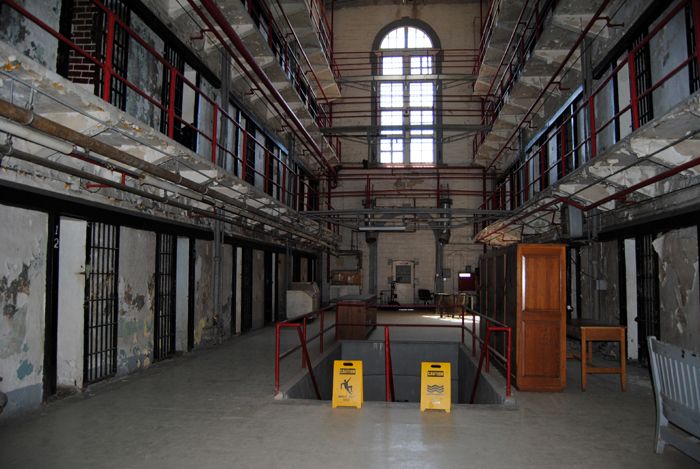
A-Hall at the Missouri State Penitentiary is the oldest building in the complex, by Kathy Alexander.
Tales of ghostly visitors began long before the prison closed with both prisoners and guards reporting having seen apparitions.
A-Hall, the prison’s oldest building is said to be a hotspot of unearthly activity. Inside the massive stone building are four tiers of cells with catwalks that criss-cross its width. The doors of the cells are less than five feet high, which forced prisoners to stoop down and take a subordinate posture when leaving their cells. Early on, inmates were not allowed to look guards in the eye, an infraction that could result in punishment at the whipping post or solitary confinement.
Within this building is a basement of dungeons, referred to as the “Hole.” Here were kept death row inmates, violent and disruptive prisoners, and those suffering from mental problems. The only light in these cells came from a small slit in the door.
One inmate, John B. “Firebug” Johnson, was housed in the dungeon for 17 years between February 26, 1883, to July 1, 1900. Prior to his placement in the dungeon, he had attempted to escape several times and had started several fires. He was moved to the basement after setting a fire that destroyed more than $500,000 worth of property and the deaths of several inmates. Amazingly, he didn’t go mad and upon his release, wrote a book called Buried Alive for 18 Years in the Missouri Penitentiary.
In this building, paranormal reports have included the feeling of having been touched by ghostly hands, an overwhelming smell of body odor, an apparition of a man spied on the catwalk, and movements in the darkness. Equipment often malfunctions here, disembodied voices have been captured on recorders, and some have felt an invisible force breathing down their necks.
Cell #48 once housed a prisoner who was known to be a snitch. He was bludgeoned to death with a sledgehammer during the prison riot of 1854. Here, people have reported having strange heavy feelings and an unearthly human figure has been caught on camera
Near the Control Room and in some of the housing units is said to lurk an entity known as “Fast Jack.” Usually spied wearing a white lab coat and carrying a clipboard, he is thought to have been a trustee who worked in the medical facilities. At one point a tour guide passed through the control center to secure the outer doors, only to return just a few minutes later to find all the lockers had been opened. This antic was attributed to Fast Jack. Others report him as having been seen in hallways moving through walls or appearing for short moments before vanishing.
In the Female Wing, a female ghostly figure is often seen dressed in vintage clothing. Others have seen a man an outdated prison uniform leaning against a fence. Strangely, some have seen or heard the ghosts of children, and others, even a dog.
Throughout the old facilities, people have heard cell doors slamming, ghostly footsteps, loud banging, shadowy figures, the smell of cigarette smoke, objects being mysteriously moved around, and fast-moving entities. They also report having felt dread, a sense of sorrow, and feeling of being watched.
Today, the Gothic style Missouri State Penitentiary ranks as one of the most incredible haunted prisons in the country, along with the Eastern State Penitentiary in Pennsylvania, the Ohio State Reformatory, and the West Virginia Penitentiary.
Several major ghost-hunting groups have conducted investigations at the prison over the years, recording ghostly voices and shadowy people.
Reservations are required for all tours. The Missouri State Penitentiary Museum is located in the old warden’s residence built by convict labor in 1888. Called the Colonel Darwin W. Marmaduke House, it sits at 700 E. Capitol Avenue across from the prison. It features artifacts, photos, and displays about the prison, including a replica cell.
More Information:
Missouri State Penitentiary
115 Lafayette Street
Jefferson City, MO 65101
573-632-2820

The old Warden’s House at the Missouri State Penitentiary serves as a museum today by Kathy Alexander
Also See:
Haunted Eastern State Penitentiary, Pennsylvania
Haunted West Virginia Penitentiary
Sources:
Jefferson City Magazine
Missouri State Penitentiary Tours
Mojo Traveler
Vintage News
Week in Weird

